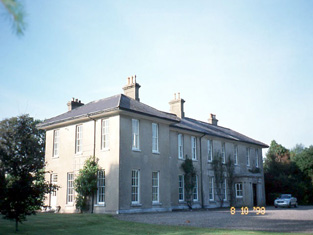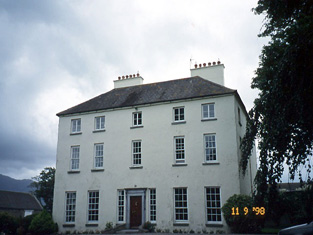Ballymalis
Houses within 5km of this house
Displaying 10 houses.
Houses within 5km of Ballymalis
Displaying 10 houses.
| House name | Description | |
|---|---|---|
| Killorglin Glebe | Rev. Robert Denny was leasing Killorglin Glebe to Rev. William de Moelyns at the time of Griffith’s Valuation, when it was valued at £16. The site now appears to be occupied by agricultural buildings. | |
| The Reeks or Baunclune | The McGillycuddy was in possession of the property at Whitefield at the time of Griffith’s Valuation when it was valued at £24 10s. Lewis and Leet also refer to Whitefield as a seat of The McGillycuddy in 1837 and 1814 respectively. Leet, however, also notes McGillycuddy Reeks as the address of McGillycuddy esq. In 1906 it was McGillycuddy property and valued at £24. Bary states that the house was originally known as The Reeks after the family title but that it was changed to Whitefield in the early 19th century by Richard McGillycuddy. However, on both the 1st and 25-edition Ordnance Survey maps it is labelled Baunclune. In more recent times it is known as The Reeks. This is how it is referred to by the Irish Tourist Association surveyor in the early 1940s who states that it was the the home of "Ross Kinloch, the MacGillycuddy of the Reeks and a member of Seanad Eireann". The house is still extant and occupied. |

|
| Churchtown | At the time of Griffith’s Valuation, Sir A. Blennerhassett was leasing Churchtown House to Robert Stokes. In 1837 Lewis refers to it as the seat of Sir A. Blennerhassett. Leet mentions it as the residence of R.A. Blennerhassett in 1814. The house was valued at £31. Churchtown House is still extant. Much of the demesne is now part of Beaufort Golf Course. |

|
| Beaufort | Reverend Edward Day was in possession of the house at Beaufort at the time of Griffith’s Valuation when it was valued at £37. Lewis refers to it as the seat of Frederick W. Mullins in 1837. In 1814 Leet also refers to it as the residence of Reverend F. Mullins. In 1786 Wilson refers to Beaufort as the seat of Hon. Dean Crosbie. Various sources, including Bary, indicate that it was built on the site of a tower house known as Short Castle. . It was sold by the Mullins estate in the mid nineteenth century to the Day family who sold it again in the 1880s. Referred to by Slater in 1894 as the seat of Lt-Col. E. Nash Leahy. It is still extant and occupied. |

|
| Cullenagh Lower | Myles Mahony was occupying a house at Cullenagh Lwr at the time of Griffith’s Valuation. It was valued at £6 and part of a holding of 176 acres. The house is not shown on thre 25-inch Ordnance Survey map of the 1890s. | |
| Gortnaskarry House | At the time of Griffith’s Valuation, Michael Horgan was leasing a property at Gortnaskarry valued at £5 from the representatives of Denis Mahony. Bary speculates that it may once have been an inn. It is still extant. | |
| Gortnaskarry Cottage | Colonel Drummond was leasing a property valued at almost £5 to John Breen at the time of Griffith’s valuation. It is labelled Gortnaskarry Cottage on the 1st edition Ordnance Survey and remains by this name on subsequent editions.A house and farm are still extant at the site. | |
| Knocknaman | Henry Denny was leasing a property valued at £9 to William Thompson at the time of Griffith’s Valuation. An uunamed house, surrounded by trees, is marked on the 1st edition OS map. There is no house at this site now. | |
| Rockfield | In 1837 Lewis noted that "Rockville" was the property of the representatives of the late John Drew. At the time of Griffith's Valuation, William Whorland was leasing a property valued at £5 10s from the Drew estate. The property was offered for sale by Alicia Wherland in the Landed Estates Court in July 1862 and again in July 1872. In 1906 Rockfield was owned by Bertram Morrogh Bernard and was valued at £11. Bary mentions it as a house associated with the Sealy family. Buildings are still extant at the site. | |
| Fahagh Court | In 1786 Wilson mentions Fagha as the seat of Mr. Falvey. At the time of Griffith's Valuation, Daniel Buckley was leasing this property from John Morrogh Bernard, when it was valued at £3 10s. In 1906 Bertram Morrogh Bernard owned this property, then valued at £25. A house built n the later nineteenth century, it is labelled Fahagh Court on the 25-inch Ordnance Survey map of the 1890s. In 1943 the Irish Tourist Association survey noted that it had been extensively reconstructed and modernised and "bears little resemblance to the historic residence of the Morrogh-Bernards and before them the O'Flavey clan". It was then occupied by the Reynolds family. Bary states that the property became a hotel in the twentieth century before being damaged by fire. The extensive yard complex has now become the Killarney Country Club and holiday accommodation. |

|

